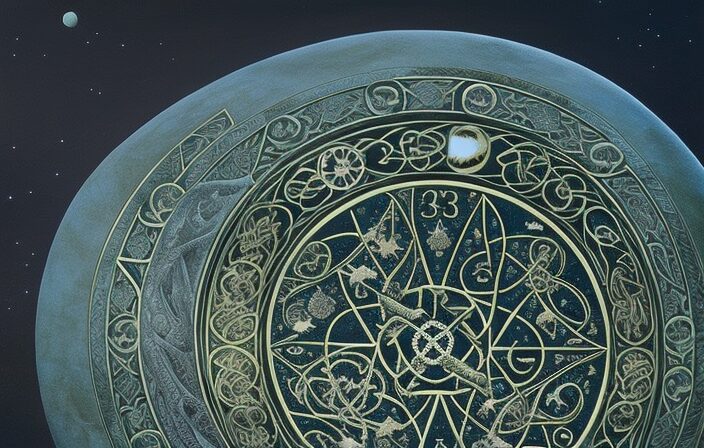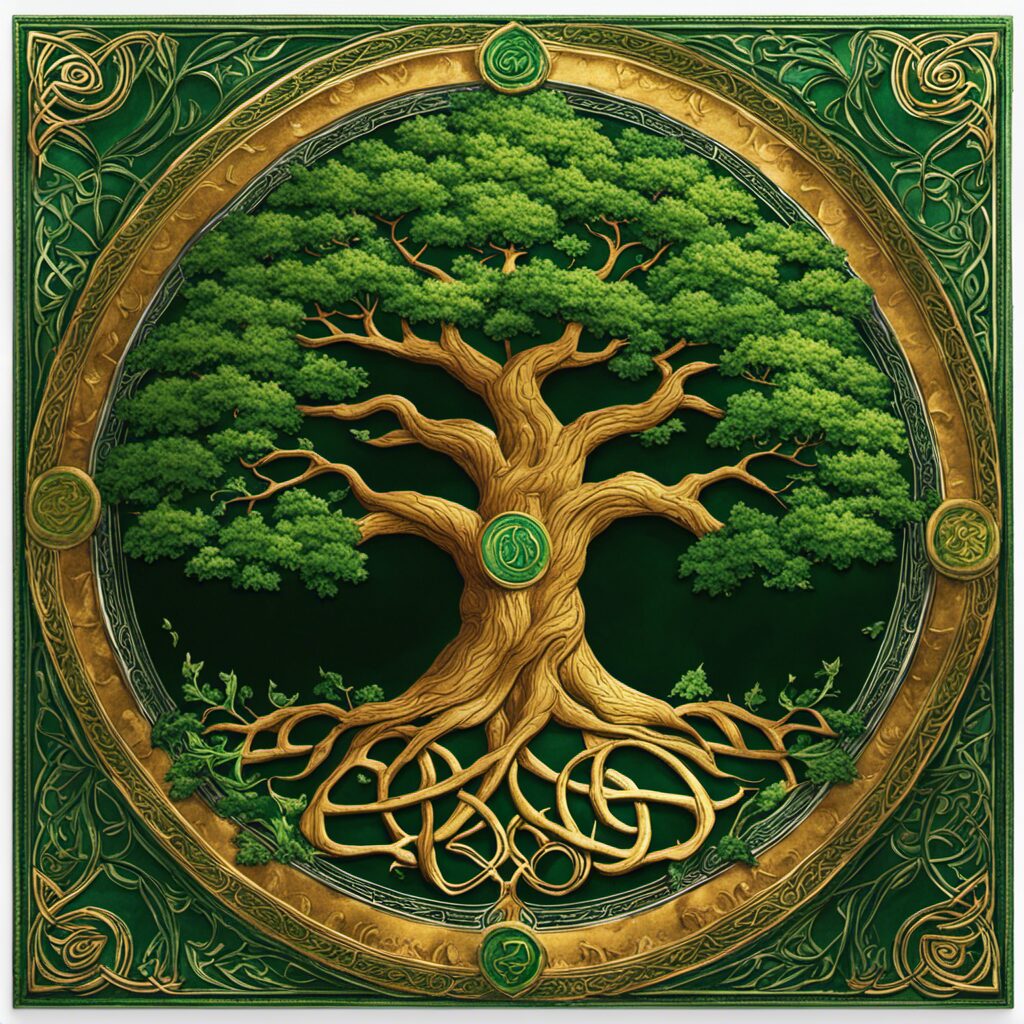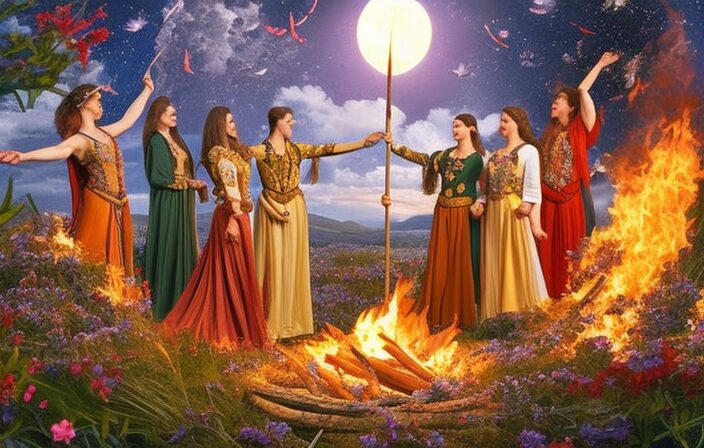Intriguing and deeply rooted in ancient traditions, Celtic calendar rituals and magic offer a fascinating glimpse into the esoteric world of Celtic rites. This article explores the Wheel of the Year, delving into the significance of each festival and associated rituals.
Additionally, it examines how Celtic magic harnesses the power of nature through its connection with the elements. Furthermore, this study unveils sacred sites and spaces that hold deep mysteries within Celtic culture.
By honoring ancestral connections and tapping into lunar magick according to the Celtic moon calendar, practitioners gain insight from their rich heritage. Divination and wisdom are also explored through the intricate system of the Celtic Tree Calendar.
Lastly, this article uncovers secret ritual tools and symbols used in Celtic magic rituals, shedding light on their hidden meanings.
Key Takeaways
- The Wheel of the Year consists of eight Sabbats spaced approximately six weeks apart throughout the year.
- Elemental rituals for magic involve working with the four classical elements: earth, air, fire, and water.
- Participating in rituals tied to each festival fosters a sense of community among believers.
- Celtic sacred sites are portals between the physical and spiritual realms.
The Wheel of the Year: Exploring Celtic Festivals and Rituals
The Wheel of the Year comprises a series of Celtic festivals and rituals that are explored in order to understand their significance and importance within the context of esoteric Celtic rites. These ancient traditions provide a framework for connecting with nature’s cycles and honoring the changing seasons.
The Wheel consists of eight Sabbats or seasonal markers, spaced approximately six weeks apart throughout the year. Each festival is associated with a specific time of year and has its own unique customs, symbols, and practices.
By exploring these ancient traditions, practitioners gain insight into the interconnectedness between humans and nature. The festivals celebrate the rhythms of life, marking key moments such as solstices, equinoxes, and agricultural milestones. Through observing these cycles, individuals develop a deeper appreciation for the natural world and their place within it.
Furthermore, participating in rituals tied to each festival helps foster a sense of community among believers. These gatherings provide an opportunity to come together in shared reverence for nature’s cycles while also acknowledging ancestral wisdom passed down through generations.
Overall, exploring the festivals and rituals of the Wheel of the Year allows individuals to engage with ancient Celtic traditions that connect them to nature’s cycles. By honoring these sacred moments throughout the year, practitioners can deepen their understanding of themselves as part of a larger cosmic tapestry.
Harnessing the Power of Nature: Celtic Magic and the Elements
Elemental rituals for magic are an integral part of Celtic magical practices, allowing practitioners to tap into the power and energy of the natural elements. These rituals often involve invoking and working with the four classical elements – earth, air, fire, and water – to harness their unique qualities and attributes.
Nature’s power in magic is revered in Celtic traditions as a source of strength and wisdom, with practitioners recognizing the interconnectedness between themselves and the natural world.
Elemental Rituals for Magic
In the realm of esoteric Celtic rites, rituals involving the manipulation of natural elements hold a prominent role in magical practices. Elemental spellwork is an ancient and powerful form of magic that harnesses the energies associated with earth, air, fire, and water to manifest desired outcomes. These rituals are based on the concept of correspondences, which link specific elements to certain intentions or goals.
Magical correspondences provide a framework for practitioners to select appropriate tools, symbols, colors, herbs, and incantations when conducting elemental spells. By aligning these components with the desired outcome and invoking the energy of the corresponding element through ritualistic practices such as visualization or chanting, individuals believe they can tap into the elemental forces of nature to manifest their intentions.
Elemental rituals for magic often involve creating sacred spaces that represent each element within a ritual circle or altar setup. This allows practitioners to interact directly with these natural energies during spellcasting. For instance, placing crystals or soil in one section of the circle may represent earth; lighting candles or incense can symbolize fire; using feathers or wind chimes signifies air; and having a small bowl filled with water represents its element.
During these rituals, practitioners may call upon deities associated with specific elements for guidance and assistance in their magical workings. For example, Brigid is often invoked during fire-related spells due to her association with inspiration and hearth fires.
The practice of elemental magic draws from ancient Celtic traditions but continues to evolve today as modern witches explore new ways to connect with nature’s elements in their spiritual practices. Whether it be through elaborate ceremonies honoring each element individually or combining them harmoniously within a larger ritual framework focused on balance and harmony between all four elements—earthly offerings continue shaping our understanding of esoteric Celtic rites.
Nature’s Power in Magic
Nature’s power plays a crucial role in the practice of magic, as it provides the energy and resources that practitioners harness to manifest their intentions. In Celtic spellcasting, nature is believed to be alive and conscious, with its own inherent power that can be tapped into through rituals and ceremonies.
Ancient Celtic rituals were deeply intertwined with nature, recognizing the interconnectedness between humans and the natural world. Nature’s influence on these rituals was evident in various ways:
-
The changing seasons: Celtic spellcasting often followed the cycles of nature, with specific spells and rituals associated with each season.
-
Sacred sites: Natural landscapes such as forests, lakes, and mountains were considered sacred spaces where magical energies were particularly potent.
-
Elemental forces: Celts revered the elements of earth, air, fire, and water as powerful entities that could be invoked during magical practices.
Sacred Sites and Sacred Spaces: Unveiling Celtic Mysteries
Sacred sites and sacred spaces play a vital role in the unveiling of Celtic mysteries. The Celts had a deep connection with the natural world, and their spiritual practices were often centered around specific locations that held significance for them. These Celtic sacred sites were believed to be portals between the physical and spiritual realms, where individuals could commune with the gods and access hidden knowledge.
One such example of a Celtic sacred site is Stonehenge, located in present-day England. This ancient stone circle has long been associated with Celtic folklore and mythology. It is believed that Stonehenge was used for religious ceremonies and astronomical observations, making it an important center for spiritual practices within the Celtic culture.
In addition to Stonehenge, other notable Celtic sacred sites include Newgrange in Ireland, Avebury in England, and Callanish on the Isle of Lewis. Each of these sites has its own unique features and associations with Celtic mythology and folklore.
Exploring these sacred spaces allows us to gain insight into the beliefs and rituals of the ancient Celts. By studying these sites through archaeological evidence and historical accounts, we can begin to unravel some of the mysteries surrounding their spiritual practices.
Ancestral Connections: Honoring Celtic Ancestors in Rituals
Ancestral connections play a significant role in Celtic spiritual practices, as rituals are performed to honor and pay tribute to their ancestors. These ancestral rituals serve as a way for the Celts to maintain their connection with their lineage and seek guidance from those who came before them. The honoring of ancestors is deeply rooted in Celtic culture and belief systems, as they believe that the spirits of their ancestors continue to influence and support them in their daily lives.
The importance of honoring ancestors can be seen through various rituals practiced by the Celts. These rituals often involve offerings such as food or drink, which are presented to the ancestors as a sign of respect and gratitude. Additionally, prayers and incantations may be recited during these rituals to invoke the presence and blessings of the ancestral spirits.
The ancestral connection is also celebrated through annual festivals such as Samhain, where it is believed that the veil between the physical world and spirit world is thinnest. During this time, special ceremonies are conducted to communicate with deceased loved ones and seek guidance from ancestral spirits.
Overall, honoring ancestors through ritualistic practices holds great significance in Celtic spirituality. It serves not only as a way to remember and show gratitude towards those who have passed on but also helps strengthen the bond between past generations and present ones.
Lunar Magick: Tapping Into the Celtic Moon Calendar
The lunar cycle holds a significant role in Celtic spiritual practices, as it is used to guide and structure various rituals and ceremonies. The Celts observed the moon’s phases closely and believed that each phase had its own unique energy and power. The Celtic calendar was lunar-based, with each month beginning on the new moon. There were thirteen months in the Celtic calendar, with each month corresponding to a specific tree or plant. These lunar phases were seen as auspicious times for performing magical workings and spellcasting.
Celtic moon phases played a crucial role in determining when certain rituals should be performed. For example, during the waxing moon phase, which represents growth and expansion, rituals for manifestation or attracting abundance would be conducted. On the other hand, during the waning moon phase, which symbolizes release and letting go, rituals for banishing negative energies or breaking bad habits would take place.
Lunar spellcasting was an integral part of Celtic magic. It involved harnessing the energy of specific moon phases to enhance the effectiveness of spells and rituals. Different types of spells were associated with different lunar phases. For instance, love spells were often cast during a full moon when emotions ran high and passions were strong.
The Celtic Tree Calendar: Divination and Wisdom From the Trees
The previous subtopic explored the significance of lunar magic in Celtic rituals. Now, we turn our attention to another important aspect of Celtic symbolism and divination: the Celtic Tree Calendar. This calendar is based on the association between certain trees and specific times of the year, reflecting the deep connection between nature and spirituality in Celtic culture.
Celtic tree symbolism holds that each tree possesses unique qualities and energies that can be tapped into for divination or wisdom. The Celtic Tree Calendar consists of thirteen lunar months, with each month corresponding to a specific tree. Here are three key aspects of this ancient practice:
-
Tree Divination: The Celtic Tree Calendar is often used as a tool for divination, providing guidance and insight into various aspects of life. By consulting the calendar and understanding the characteristics associated with each tree, individuals can seek answers to questions or gain clarity on their current circumstances.
-
Symbolic Meanings: Each tree in the calendar represents different symbolic meanings within Celtic mythology and folklore. For example, oak trees symbolize strength and endurance, while willow trees represent intuition and healing.
-
Seasonal Significance: The timing of specific trees within the calendar aligns with seasonal changes, allowing practitioners to connect with nature’s cycles. This connection fosters a deeper understanding of natural rhythms and facilitates spiritual growth.
Ritual Tools and Symbols: Uncovering the Secrets of Celtic Magic
Ritual tools and symbols play a significant role in Celtic practices, providing practitioners with tangible objects and visual representations to enhance their spiritual experiences. These tools and symbols are deeply rooted in the Celtic culture and hold great importance in various magical rituals.
Celtic symbols are rich in meaning and serve as powerful conduits for invoking specific energies or deities. One of the most well-known Celtic symbols is the triquetra, which represents the interconnectedness of mind, body, and spirit. The triskelion symbolizes eternal motion and the cycles of life, while the Celtic knot represents infinite love and unity.
Magical tools are also essential components of Celtic rituals. The athame, a ritual knife with a black handle, is used to direct energy during ceremonies. The cauldron is seen as a vessel of transformation and rebirth, often associated with the goddess Cerridwen. Wands made from sacred woods such as oak or willow are used for channeling energy and casting spells.
In addition to these tools, certain natural elements hold symbolic significance in Celtic magic. Stones like quartz or amethyst represent grounding energies, while herbs such as sage or lavender are used for purification purposes.
Overall, ritual tools and symbols have deep meanings within Celtic practices, allowing practitioners to connect with ancient traditions and tap into mystical forces that shape their spiritual journey.
Conclusion
In conclusion, the Celtic calendar rituals and magic encompass a rich tapestry of ancient traditions that connect individuals to the cycles of nature and their ancestral heritage. As the Wheel of the Year turns, these esoteric Celtic rites provide a means for harnessing the power of nature and tapping into its elemental forces. Through sacred sites and spaces, practitioners unveil hidden mysteries and honor their Celtic ancestors in profound rituals.
The lunar magick and Celtic Tree Calendar further deepen this connection with celestial bodies and natural wisdom. With ritual tools and symbols as guides, one can unlock the secrets of Celtic magic, allowing for personal transformation and spiritual growth.
Metaphor: Like a thread weaving through time, these ancient practices bind us to our roots, reminding us of our interconnectedness with nature’s rhythms and our ancestral lineage.




